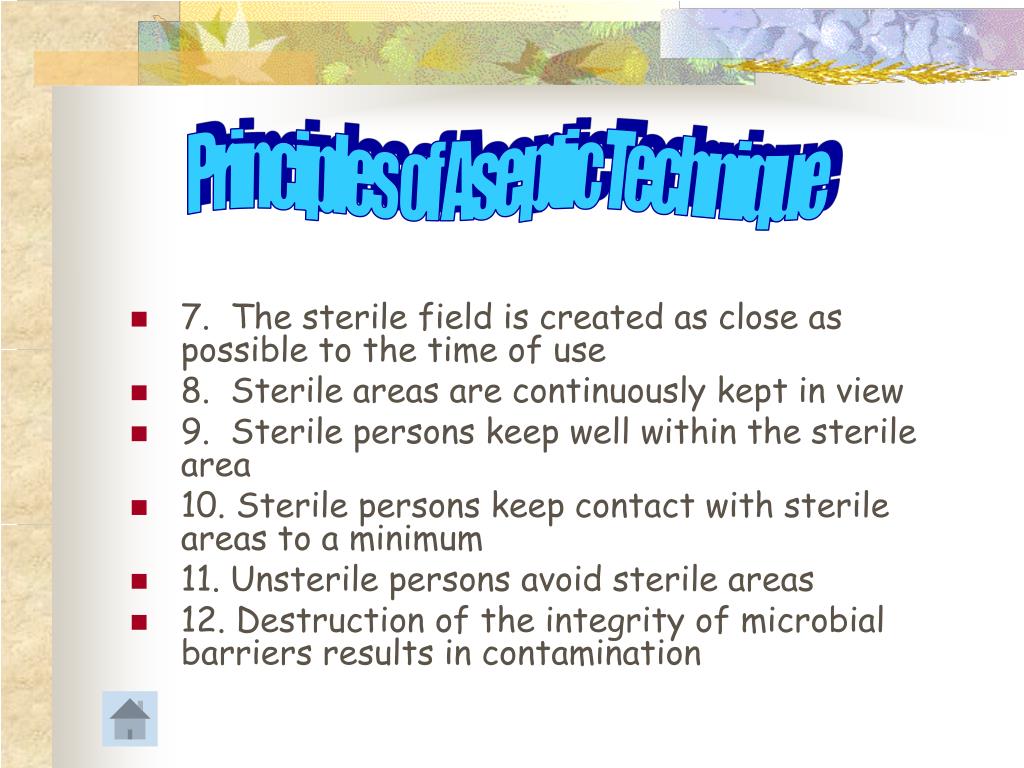
( accessed 4 February 2020) Google Scholar Nurse education and the assessment of nurse competence. ANTT: a standard approach to aseptic technique. New York (NY): Oxford University Press 2007 Google Scholar The philosophy of psychiatry: a companion. ( accessed 9 January 2020) Google Scholar Surveillance of surgical site infections in NHS hospitals in England, 2017 to 2018.
#Four principles of asepsis professional
Professional standards of practice and behaviour for nurses, midwives and nursing associates. Aseptic non-touch technique (ANTT) procedure ICPr014.

Standard Principles for preventing hospital-acquired infections. Finding the evidence: a key step in the information production process. Step-by-step guide to critiquing research: Part 1: quantitative research. Putting it into practice: infection control professionals' perspectives on early career nursing graduates' microbiology and infection control knowledge and practice. Cox JL, Simpson MD, Letts W, Cavanagh HMA.An examination of nurses' practices when performing aseptic technique for wound dressings. The effect of teaching method on long-term knowledge retention. Maidenhead: Open University Press 2018 Google Scholar


Doing a literature review in health and social care. (16)30402-9 Crossref, Medline, Google Scholar New WHO recommendations on intraoperative and postoperative measures for surgical site infection prevention: an evidence-based global perspective. Allegranzi B, Zayed B, Bischoff P et al.Reducing surgical nurses' aseptic practice-related stress.

Given that the role of the perioperative nurse is paramount in maintaining surgical integrity, and enhancing positive patient outcomes, strict adherence to surgical asepsis is vital to prevent SSIs and other complications. The findings showed areas of compliance and noncompliance with the principles of asepsis. Perioperative scrub RNs were less likely to wear shoe covers during surgical procedures than ORTs (M = 3.42 and 4.17 mdn = 3.00 and 5.00 respectively p =. The purpose of this study was to examine the practices of perioperative scrub personnel with surgical asepsis.Ī sizable percentage of participants indicated that they never or rarely observe breaches in the sterile field during surgery with regards to open suction drain systems (46.6% n = 41), closed suction drain systems (46.6% n = 41), suture material (39.7% n = 35), use of surgical instruments (37.5% n = 33), and prosthetic implants (56.8% n = 50). Perioperative nurses are expected to demonstrate strict adherence with asepsis principles to prevent surgical site infections (SSIs) as breaching of these principles poses a serious risk of infection to surgical patients.Ī descriptive survey was conducted with a convenience sample of 87 perioperative personnel to describe self-reported compliance with the principles of asepsis during surgery.


 0 kommentar(er)
0 kommentar(er)
